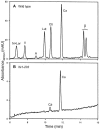White mutants of Chlamydomonas reinhardtii are defective in phytoene synthase
- PMID: 15579683
- PMCID: PMC1448780
- DOI: 10.1534/genetics.104.030635
White mutants of Chlamydomonas reinhardtii are defective in phytoene synthase
Abstract
Carotenoids play an integral and essential role in photosynthesis and photoprotection in plants and algae. A collection of Chlamydomonas reinhardtii mutants lacking carotenoids was characterized for pigment and tocopherol (vitamin E) composition, growth phenotypes under different light conditions, and the molecular basis of their mutant phenotype. The carotenoid-less mutants, or "white" mutants, were also deficient in chlorophylls but had approximately twice the tocopherol content of the wild type. White mutants grew in the dark but were unable to survive in the light, even under very low light conditions on acetate-containing medium. Genetic crosses and recombination tests revealed that all individual white mutants in the collection are alleles of a single gene, lts1, and the white phenotype was closely linked to a marker located in the phytoene synthase gene. DNA sequencing of the phytoene synthase gene from each of the mutants revealed nonsense, missense, frameshift, and splice site mutations. Transformation with a wild-type copy of the phytoene synthase gene was able to complement the lts1-210 mutation. Together, these results show that all the white mutants examined in this work are affected in the phytoene synthase gene.
Figures






Similar articles
-
The requirement for carotenoids in the assembly and function of the photosynthetic complexes in Chlamydomonas reinhardtii.Plant Physiol. 2013 Jan;161(1):535-46. doi: 10.1104/pp.112.205260. Epub 2012 Nov 16. Plant Physiol. 2013. PMID: 23161889 Free PMC article.
-
Regulation of carotenoid biosynthesis genes in response to light in Chlamydomonas reinhardtii.Biochim Biophys Acta. 2002 Nov 13;1579(1):26-34. doi: 10.1016/s0167-4781(02)00500-6. Biochim Biophys Acta. 2002. PMID: 12401216
-
The ultrastructure of a Chlamydomonas reinhardtii mutant strain lacking phytoene synthase resembles that of a colorless alga.Mol Plant. 2008 Nov;1(6):925-37. doi: 10.1093/mp/ssn046. Epub 2008 Sep 19. Mol Plant. 2008. PMID: 19825593 Free PMC article.
-
Enhancement of carotenoids biosynthesis in Chlamydomonas reinhardtii by nuclear transformation using a phytoene synthase gene isolated from Chlorella zofingiensis.Appl Microbiol Biotechnol. 2011 Jul;91(2):341-51. doi: 10.1007/s00253-011-3262-y. Epub 2011 Apr 26. Appl Microbiol Biotechnol. 2011. PMID: 21519934 Free PMC article.
-
[Bio-chemoprevention of cancer].Gan To Kagaku Ryoho. 1997 Jul;24(9):1047-52. Gan To Kagaku Ryoho. 1997. PMID: 9239155 Review. Japanese.
Cited by
-
One amino acid substitution in phytoene desaturase makes Chlorella zofingiensis resistant to norflurazon and enhances the biosynthesis of astaxanthin.Planta. 2010 Jun;232(1):61-7. doi: 10.1007/s00425-010-1132-y. Epub 2010 Mar 10. Planta. 2010. PMID: 20221629
-
A kiwifruit (Actinidia deliciosa) R2R3-MYB transcription factor modulates chlorophyll and carotenoid accumulation.New Phytol. 2019 Jan;221(1):309-325. doi: 10.1111/nph.15362. Epub 2018 Aug 1. New Phytol. 2019. PMID: 30067292 Free PMC article.
-
Complete chloroplast genomes of the Chlamydomonas reinhardtii nonphotosynthetic mutants CC-1375, CC-373, CC-4199, CC-2359 and CC-1051.Mitochondrial DNA B Resour. 2017 Jul 11;2(2):405-407. doi: 10.1080/23802359.2017.1347838. Mitochondrial DNA B Resour. 2017. PMID: 33473842 Free PMC article.
-
Cloning and selection of carotenoid ketolase genes for the engineering of high-yield astaxanthin in plants.Planta. 2012 Aug;236(2):691-9. doi: 10.1007/s00425-012-1654-6. Epub 2012 Apr 22. Planta. 2012. PMID: 22526507
-
The requirement for carotenoids in the assembly and function of the photosynthetic complexes in Chlamydomonas reinhardtii.Plant Physiol. 2013 Jan;161(1):535-46. doi: 10.1104/pp.112.205260. Epub 2012 Nov 16. Plant Physiol. 2013. PMID: 23161889 Free PMC article.
References
-
- Albrecht, M., A. Klein, P. Hugueney, G. Sandmann and M. Kuntz, 1995. Molecular cloning and functional expression in E. coli of a novel plant enzyme mediating zeta-carotene desaturation. FEBS Lett. 372: 199–202. - PubMed
-
- Asamizu, E., K. Miura, K. Kucho, Y. Inoue, H. Fukuzawa et al., 2000. Generation of expressed sequence tags from low-CO2 and high-CO2 adapted cells of Chlamydomonas reinhardtii. DNA Res. 7: 305–307. - PubMed
-
- Britton, G., 1995. Structure and properties of carotenoids in relation to function. FASEB J. 9: 1551–1558. - PubMed
-
- Chamovitz, D., G. Sandmann and J. Hirschberg, 1993. Molecular and biochemical characterization of herbicide-resistant mutants of cyanobacteria reveals that phytoene desaturation is a rate-limiting step in carotenoid biosynthesis. J. Biol. Chem. 268: 17348–17353. - PubMed
Publication types
MeSH terms
Substances
Associated data
- Actions
- Actions
- Actions
- Actions
Grants and funding
LinkOut - more resources
Full Text Sources
Other Literature Sources

